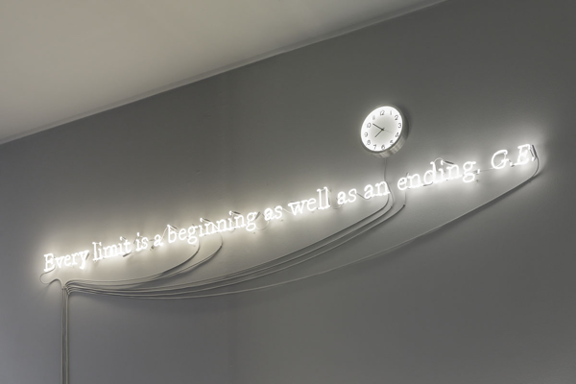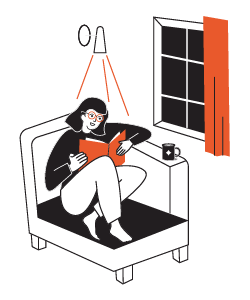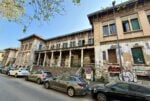Joseph Kosuth – The Question

Nuova importante mostra personale di Joseph Kosuth dal titolo ‘The Question’, che segna il ritorno dell’artista in città.
Comunicato stampa
La Galleria Lia Rumma di Napoli inaugura, giovedì 10 aprile 2025, la nuova importante mostra personale di Joseph Kosuth dal titolo ‘The Question’, che segna il ritorno dell’artista in città.
L’artista americano Joseph Kosuth (Toledo/Ohio, 1945), considerato uno dei pionieri dell’Arte Concettuale, che ha da poco festeggiato il suo ottantesimo compleanno con varie mostre organizzate* tra Europa e America, torna ad esporre a Napoli confermando la solida e duratura collaborazione con Lia Rumma che nel 1971 ha aperto la sua galleria proprio con Kosuth, con una installazione passata alla storia: L’Ottava Investigazione (A.A.I.A.I.) proposizione 6. Un rapporto professionale con Lia Rumma, ma anche di amicizia, che ha visto Kosuth esporre ulteriori volte nel tempo, oltre che nella sede napoletana anche in quella di Milano.
In questo nuovo progetto espositivo, Kosuth ritorna a riflettere sul concetto di “tempo” che prende avvio da un’urgenza sia personale che filosofica. Una riflessione che assume la forma di una indagine sul processo di produzione di significato nella sua pratica artistica, presentando una serie di lavori realizzati in vari momenti della sua carriera. Perché come scriveva Borges: “Se lo spazio è infinito, siamo in qualsiasi punto dello spazio. Se il tempo è infinito, siamo in qualsiasi punto del tempo”.
‘The Question’, oltre ad essere il titolo della mostra, rimanda anche ad un nuovo lavoro del 2025: un grande orologio a parete su cui compare la frase Suppose no one asked a question, what would be the answer (“Se nessuno facesse una domanda, quale sarebbe la risposta”, citazione del 1928 della scrittrice americana Gertrude Stein). Il tempo è così citato sia letteralmente (con le lancette che segnano un’ora scelta dall’artista) che figurativamente attraverso un rimando ad un altro autore. Ma la presenza di un orologio analogico (nell’installazione del 1971 da Lia Rumma ce n’erano 12), si ritrova in altri due lavori della serie “Existential Time” (2019), questa volta accompagnati da due citazioni al neon di George Eliot e James Joyce, nei quali Kosuth tende a sottolineare la mancanza, i limiti e la sovrabbondanza di significato che circonda l’esperienza del tempo e della vita, esplorando il presente, la sua potenza e il suo spazio circoscritto.
In mostra anche One and three Rakes (1965) con il quale si fa un salto indietro nel tempo e si ritorna alle “Proto–Investigazioni” degli anni 1965-’66. Un lavoro iconico che presenta, accostati, l’oggetto reale (il rastrello), una fotografia del rastrello e la sua definizione tratta da un dizionario che descrive il termine in tutti i suoi vari significati. Assemblando un oggetto, una fotografia di quell'oggetto e una definizione ingrandita tratta da un dizionario, Joseph Kosuth mette lo spettatore di fronte alla complessità di un sistema linguistico tanto più articolato quando si confronta con quello dell'arte. «L'arte che chiamo concettuale è tale perché si basa su un'indagine sulla natura dell'arte - ha sottolineato più volte Kosuth -. Fondamentale per questa idea di arte è la comprensione della natura linguistica di tutte le proposte artistiche, siano esse passate o presenti, e indipendentemente dagli elementi utilizzati per la loro costruzione».
* Sprüth Magers, Londra (gennaio – marzo 2025); Sean Kelly, New York (marzo – aprile 2025)
Joseph Kosuth (1945, USA) è uno dei pionieri dell’arte concettuale e dell’arte installativa, iniziando negli anni Sessanta con opere che indagano il linguaggio e le strategie di appropriazione. Il suo lavoro ha esplorato coerentemente la produzione e il ruolo del significato all’interno dell’arte. La sua oltre cinquantennale indagine sul rapporto tra linguaggio e arte si è manifestata attraverso installazioni, mostre in musei, commissioni pubbliche e pubblicazioni in Europa, le Americhe e l’Asia. Kosuth ha partecipato tra l’altro a sette Documenta e quattordici Biennali di Venezia una delle quali presentata al Padiglione Ungherese (1993). Tra i riconoscimenti possiamo citare il Brandeis Award del 1990, il Frederick Weisman Award del 1991, la Menzione d’Onore alla Biennale di Venezia del 1993 e il titolo di Chevalier de l’Ordre des Arts et des Lettres assegnatogli nel 1993 dal governo francese e nel 1999 lo stesso governo ha emesso un francobollo da 3.00 Franchi in onore del suo lavoro a Figeac. Nel 2001 ha ricevuto la Laurea Honoris Causa in Lettere e Filosofia dall’Università di Bologna. È del 2003 la Croce di Cavaliere di Prima Classe al Merito della Repubblica d’Austria, il massimo riconoscimento nelle scienze e nelle arti. Nel 2012 Kosuth ha ricevuto la Classe des Arts de l’Académie Royale dall’Accademia Reale delle Scienze, Lettere e Belle Arti del Belgio. Nel 2015 l’Instituto Superior de Arte dell’Università di L’Avana gli ha conferito un Dottorato Honoris Causa durante la XXII Havana Bienial dove ha esposto una grande installazione alla Bibiolteca Nacional. Nel 2025, riceve un Diploma Honoris in Comunicazione e Valorizzazione del Patrimonio Artistico Contemporaneo dall’Accademia Albertina di Belle Arti di Torino.
Lia Rumma Gallery in Naples is pleased to announce the opening, on Thursday 10 April, of Joseph Kosuth’s major solo exhibition ‘The Question’, which marks the artist’s return to the city.
The American artist Joseph Kosuth (Toledo/Ohio, 1945), considered one of the pioneers of Conceptual art, has recently celebrated his eightieth birthday with various exhibitions organised* in Europe and America. He returns to Naples for an exhibition that confirms his solid, longlasting collaboration with Lia Rumma who actually opened her gallery in 1971 with Kosuth with an installation that was to make history: The Eighth Investigation (A.A.I.A.I.) Proposition 6. His professional relationship and friendship with Lia Rumma has led Kosuth to hold several exhibitions in the Lia Rumma galleries over time, both in Naples and Milan.
In this new exhibition, Kosuth reflects once again on the concept of “time” which stems both from a personal and philosophical urgency. His reflections have led to an inquiry into the process of creating meaning in his artistic practice, presenting a series of works made at various stages of his career. Because, as Borges wrote, “If space is infinite, we may be at any point in space. If time is infinite, we may be at any point in time”.
Besides being the title of the exhibition, ‘The Question’ is a reference to a new work made in 2025: a large wall clock with the quotation Suppose no one asked a question, what would be the answer?, a remark made by the American writer Gertrude Stein in 1928. Time is therefore mentioned both literally (with the hands indicating a time chosen by the artist) and figuratively through the reference to another author. However, the presence of an analogue clock (in the installation in the Lia Rumma Gallery in 1971, there were 12 clocks) also features in two other works in the series “Existential Time” (2019), on this occasion accompanied by two quotations in neon taken from George Eliot and James Joyce, in which Kosuth seeks to underline the lack, limits and superabundance of meaning that surrounds the experience of time and life, exploring the present, its power and its confined space.
The exhibition also includes the work One and three Rakes (1965) which marks a step back in time and a return to the “Proto–Investigations” of the years 1965-1966. This iconic work presents exhibits placed side by side: the actual object (a rake), a photograph of the rake and its definition taken from a dictionary that describes the term in all its various meanings. By assembling an object, a photograph of the object and an enlarged dictionary definition, Joseph Kosuth presents the viewer with a linguistic system that becomes far more complex when confronted with that of art. “The art I call conceptual is such because it is based on an inquiry into art”, Kosuth has stated on various occasions. “Fundamental to this idea of art is the understanding of the linguistic nature of all art propositions, be they past or present, and regardless of the elements used in their construction”.
* Sprüth Magers, London (January – March 2025); Sean Kelly, New York (March – April 2025)
Joseph Kosuth (b 1945, USA) is one of the pioneers of Conceptual art and installation art, initiating language based works and appropriation strategies in the 1960s. His work has consistently explored the production and role of language and meaning within art. His more than fifty year inquiry into the relation of language to art has taken the form of installations, museum exhibitions, public commissions and publications throughout Europe, the Americas and Asia, including seven Documenta(s) and 14 Venice Biennale(s), one of which was presented in the Hungarian Pavilion (1993). Awards include the Brandeis Award, 1990, Frederick Wiseman Award, 1991, the Menzione d'Onore at the Venice Biennale, 1993, and the Chevalier de l'ordre des Arts et des Lettres from the French government in 1993. In June 1999, a 3.00 franc postage stamp was issued by the French Government in honor of his work in Figeac. In February 2001, he received the Laura Honoris Causa, doctorate in Philosophy and Letters from the University of Bologna. In October 2003 he received the Austrian Republic’s highest honour for accomplishments in science and culture, the Decoration of Honour in Gold for services to the Republic of Austria. In 2012 Kosuth received la classe des Arts de l’Académie Royale from the Académie Royale Sciences des Lettres et des Beaux-Arts of Belgium. In 2015 the Instituto Superior de Arte, at the University of Havana, awarded him an Honoris Causa doctorate, presented during the 12th Havana Art Biennial where he exhibited an extensive installation at the Biblioteca Nacional. In 2025, he receives an Honorary Diploma in Communication and Enhancement of Contemporary Artistic Heritage from the Albertina Academy of Fine Arts in Turin.



